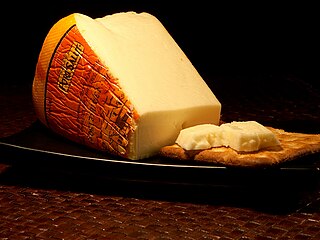
Port Salut is a semi-soft pasteurised cow's milk cheese from Pays de la Loire, France, with a distinctive orange rind and a mild flavour. The cheese is produced in wheels approximately 23 cm (9 inches) in diameter, weighing approximately 2 kg (4.4 lb).
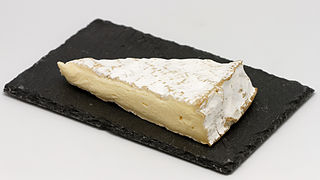
Brie is a soft cow's-milk cheese named after Brie, the French region from which it originated. It is pale in colour with a slight greyish tinge under a rind of white mould. The rind is typically eaten, with its flavour depending largely upon the ingredients used and its manufacturing environment. It is similar to Camembert, which is native to a different region of France. Brie typically contains between 60% and 75% butterfat, slightly higher than Camembert.

Oka is a semi-soft washed rind cheese that was originally manufactured by Trappist monks located in Oka, Quebec, Canada. The cheese is named after the town. It has a distinct flavour and aroma, and is still manufactured in Oka, although now by a commercial company. The recipe was sold in 1981 by Les Pères Trappistes to the Agropur cooperative.
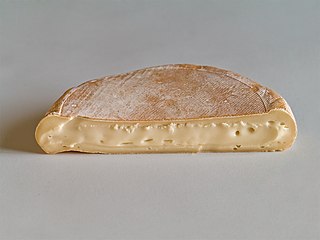
Reblochon is a soft washed-rind and smear-ripened French cheese made in the Alpine region of Haute-Savoie from raw cow's milk. It has its own AOC designation.

Chimay Brewery is a brewery at Scourmont Abbey, a Trappist monastery in Chimay, Hainaut, Belgium, one of the thirteen breweries worldwide that produce Trappist beer. They make four ales: Chimay Rouge, Chimay Bleue, Chimay Blanche, and Chimay 150; and one patersbier for the monks. The monastery also makes four varieties of cheese.

Cantal cheese is an uncooked firm cheese produced in the Auvergne region of central France: more particularly in the département of Cantal as well as in certain adjoining districts. Cantal cheese was granted Appellation d'Origine Contrôlée certification in 1956. One of the oldest cheeses in France, Cantal dates back to the times of the Gauls. It came to prominence when Marshal Henri de La Ferté-Senneterre served it at the table of Louis XIV of France. Senneterre is also responsible for the introduction of Saint-Nectaire and Salers.

Beaufort is a firm, raw cow's milk cheese associated with the gruyère family. An Alpine cheese, it is produced in Beaufortain, Tarentaise valley and Maurienne, which are located in the Savoie region of the French Alps.

Banon is a French cheese made in the region around the town of Banon in Provence, south-east France.

Pont-l'Évêque is a French cheese, originally manufactured in the area around the commune of Pont-l'Évêque, between Deauville and Lisieux in the Calvados département of Normandy. It is probably the oldest Norman cheese still in production.

Saint-Nectaire is a French cheese made in the Auvergne region of central France.

Laguiole, sometimes called Tome de Laguiole, is a pressed uncooked French cheese from the plateau of Aubrac, situated at between 800 - 1400m, in the region of Aveyron in the southern part of France. It takes its name from the small town of Laguiole and has been protected under the French Appellation d'Origine Contrôlée (AOC) since 1961 and a Appellation d'origine protégée since 1996. Laguiole is said to have been invented at a monastery in the mountains of Aubrac in the 19th century. According to historical accounts, the monks passed down the recipe for making this cheese from cattle during the alpages to the local buronniers, the owners of burons, or mountain huts.
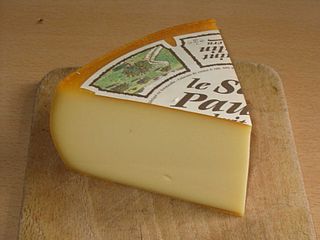
Saint Paulin is a creamy, mild, semi-soft French cheese made from pasteurized cow's milk, originally made by Trappist monks at Saint Paulin. It is a buttery cheese, but firm enough for slicing. Saint Paulin is similar to Havarti and Esrom, and is suited to serving as a table or dessert cheese; it is often served with fruit and light wine. Genuine Saint Paulin has an edible yellow-orange rind. It is ripened in a round loaf with slightly protruding sides, and matures in about four weeks.
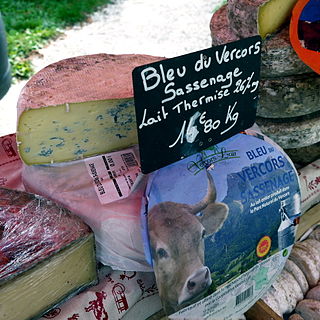
Bleu du Vercors-Sassenage is a mild pasteurized natural rind cow's milk blue cheese originally produced by monks in the Rhône-Alpes region of France in the 14th century. Now made in the Dauphiné area, the cheese has been a protected Appellation d'Origine Contrôlée since 1998. As a requirement, the cheese has to be composed of milk from Montbéliard, Abondance or Villard cows. The cheese is unpressed and uncooked and contains the mold Penicillium roqueforti. In Larousse's Grand Dictionnaire Universel of the 19th century, King Francis I is described as being quite fond of the cheese.

Tête de Moine AOP is a semi-hard cheese manufactured in Switzerland. It is classified as a Swiss-type or Alpine cheese, and was invented and initially produced more than eight centuries ago by the canons of the abbey of Bellelay, located in the community of Saicourt, district of Moutier, in the mountainous zone of the Bernese Jura, the French-speaking area of the Canton of Bern as well as the Canton of Jura.

Mottin charentais, previously known as crottin charentais is a French soft double-cream cheese made of pasteurized whole cow's milk, produced by Savencia Fromage & Dairy in the town of Saint-Saviol located within the Vienne department.
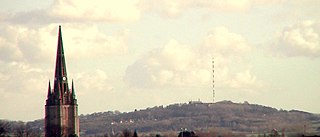
Mont des Cats is a small hill near the town of Godewaersvelde, France. Located in the Nord department, its Flemish name is Katsberg. The hill is seat of the Mont des Cats abbey, famous for its cheese produced by monks since 1890.

Abbaye de Tamié is a soft cheese made from unpasteurised cow's milk, similar in style to Reblochon and produced exclusively by the monks of Tamié Abbey, near to Albertville in the Savoie département, in the French Alps.
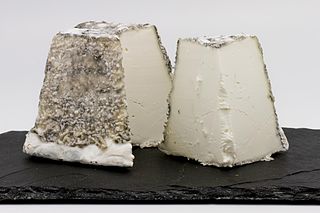
There are many different types of cheese. Cheeses can be grouped or classified according to criteria such as length of fermentation, texture, methods of production, fat content, animal milk, and country or region of origin. The method most commonly and traditionally used is based on moisture content, which is then further narrowed down by fat content and curing or ripening methods. The criteria may either be used singly or in combination, with no single method being universally used.

Trappist monks started producing Mont des Cats cheeses in 1890. The cheese is produced using cows milk from local sources and has a fat content of 50%. While maturing for at least two months the cheese is washed with salted water containing a dye made from annatto seeds which gives the rind its characteristic orange color.



















